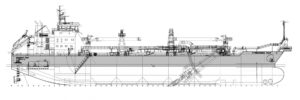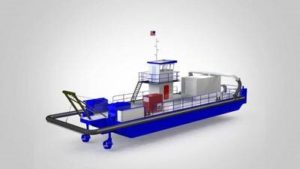Source: Watermaster
BY STAS MARGARONIS
A new report published by Tulane University’s Institute on Water Resources Law & Policy warns that the high cost of U.S. dredging, caused by high shipbuilding costs and a lack of dredging vessels, will undermine the nation’s ability to defend against coastal erosion and sea level rise.
The study, “Building Resiliency in America’s Coastline” was published by the Tulane Institute on Water Resources Law & Policy. The report “has been produced with the assistance of the European Union” and is authored by Caitlin Cain an urban planner and economic developer. Cain is the former CEO of the World Trade Center of New Orleans.[1]
The report compares two reclamation projects in the European Union (EU) – Belgium and The Netherlands — to the Ship Island reclamation project in Mississippi and found that U.S. dredging costs are 400% to 500% higher than in Europe:
“As the above case studies illustrate, dredging is a key nature-based solution tool for many coastal restoration initiatives in both the EU and the U.S. However, dredging in the U.S. is much more expensive than in the EU. De Haan Beach (Belgium) utilized 1.4 million cubic meters of sand at a cost of €10 million. The Sand Engine (Netherlands) utilized 21.5 million cubic meters of sand at a cost of €70 million. Compare this to Ship Island in the U.S., which utilized 19 million cubic yards (or 14.5 million cubic meters) of sand at a cost of $368 million (equating to approximately €308 million). The U.S. example is a fraction of the size of EU projects but four to five times the cost.”[2]
The situation has caused concerns from the U.S. Army Corps of Engineers: “What we’re seeing right now is a massive demand on a limited dredge fleet,” Col. Stephen Murphy, commander of the U.S. Army Corps of Engineers’ New Orleans District told the New Orleans Times-Picayune: “So as the state looks to do a lot of coastal restoration projects … what I foresee is increasing competition. With that limited supply and increasing demand, it won’t surprise me if prices go up.”[3]
HIGH U.S. COSTS
A 2014 Congressional General Accounting Office (GAO) audit describing the lack of productivity of U.S dredging was cited in the report. The GAO audit said:
“According to the (U.S. Army Corps of Engineers) Corps, of the approximately $11 billion it spent for dredging from fiscal year 2003 through fiscal year 2012, about $2.37 billion was for hopper dredging. Of that, industry hopper dredges accounted for about $1.8 billion, and Corps hopper dredges accounted for about $570 million. Corps spending on hopper dredging has more than doubled since fiscal year 2003, while the amount of material removed by hopper dredges has increased only slightly over that period, according to Corps data. Specifically, as shown in figure 2, the Corps spent nearly $170 million for Corps and industry hopper dredges to remove around 66 million cubic yards of material in fiscal year 2003. By fiscal year 2012, Corps spending on Corps and industry hopper dredging had increased to about $370 million, while the amount of material removed increased to nearly 72 million cubic yards. This growth in spending reflects costs for hopper dredging that, according to Corps documents, have increased because of rising costs for fuel and steel, among other factors.”[4]
JONES ACT BLAMED
The Tulane report blames the U.S build requirements of the Jones Act and the Foreign Dredge Act for discouraging foreign competition for high costs and inefficiencies:
“New policy approaches are needed to limit the inefficiencies (such as high per-unit costs) that currently characterize the U.S. dredging sector. The largest obstacles to reducing these inefficiencies lies in re-thinking current U.S. protectionist policies, namely the Jones and Foreign Dredge Acts. Currently, both the Jones Act (or Merchant Marine Act) of 1920 and the Foreign Dredge Act of 1906 prohibit foreign built and chartered or operated dredges from competing in the U.S. The Jones Act focuses on protecting U.S. interests in the transportation of goods and materials (known as cabotage), while the Dredging Act restricts the use of dredgers to those vessels that are U.S. built, U.S. owned, U.S. flagged and U.S. staffed. Essentially the act prevents any dredging from a foreign built, chartered, owned or crewed vessel.”[5]
HIGH U.S. SHIPBUILDING COSTS
The result is that dredging vessels built in the United States for Jones Act customers are 700% to 800% more expensive than dredging vessels built in the European Union:
“In addition to U.S. dredges being few in number, they are also more expensive than their EU counterparts to construct. U.S. built vessels cost between $190M-$250M compared to $30M in the EU (Grabow, Manak, & Ikenson, 2018; Collis & Fenili, 2018) and the average age of a U.S. hopper dredge is older than those found in the EU – the average age of a Jones Act vessel is 30 years. This is even more striking when you compare investment in shipyards. In the U.S., there are 7 main shipyards, while in the EU there are 60 – the majority of which are producing larger hopper vessels greater than 150 meters (Grabow, Manak, & Ikenson, 2018). U.S. shipyards have become reliant on government military contracts, which accounted for 70 percent of the shipbuilding and ship‐repairing industries’ revenues in 2014 (Grabow, Manak, & Ikenson, 2018). Private sector investment in new vessels, particularly hopper dredges, has significantly decreased and continues to pale in comparison to international competitors, putting the U.S. shipbuilding market, and associated jobs, at a significant disadvantage.”[6]
The report cited the difference in capabilities of U.S. dredgers compared to European dredgers.
Dredging Vessel Capacity: U.S. vs. Belgium
U.S. Hopper Dredges Belgium Hopper Dredges
Name Highest Capacity (cubic yards) Name Highest Capacity (cubic yards)
Glenn Edwards, Manson 13,500 Congo River, DEME Group 39,487
Stuguesant, Dutra Group 9,870 Pearl River, DEME Group 31,561
Ellis Island, Great Lakes 15,000 Christobal Colon, Jan De Nul 60,000
Source: Tulane Institute on Water Resources Law & Policy
In fact, “the combined capacity of the U.S. fleet is less than a single EU dredging vessel. Dredging is critical for coastal protection and defense against climate change, yet the U.S. lags way behind other countries…”
U.S DREDGING COMPANIES BUILDING NEW VESSELS
U.S. dredging companies have begun to invest in new dredging vessels to modernize the U.S. fleet.
In September 2020, Manson Construction Co. announced it had contracted with Keppel AmFELS to build the hopper dredge FREDERICK PAUP at their facility in Brownsville, TX. The 15,000 cubic yard hopper dredge — designed in collaboration with Hockema Whalen Myers Associates, Inc. of Seattle, WA — has a length of 420-ft, breadth of 81-ft and draft of 28.5-ft. The dredge is slated to be fully operational come spring 2023.
Source: Manson Construction
“We are pleased to be partnering with Keppel AmFELS, due to their impressive vessel construction capabilities. Their value proposition is strengthened by our shared focus on safety,” said John Holmes, Manson Construction Co. president.
Mohamed Sahlan Bin Salleh, president of Keppel AmFELS said, “We are pleased to be selected by Manson Construction Co. to build the largest U.S hopper dredger. It is a testament to the capabilities of our shipyard to build a wide variety of vessels for the Jones Act market.
Netherlands-based Royal IHC said it has been awarded a contract to design and build a Jones Act compliant dredger for the North Carolina State Ports Authority (NCSPA) for delivery in 2021, according to Marine Link.
The water injection dredger will be built at a partner shipyard in the U.S:
“The construction, procurement of the main components, assembly and testing will be performed in the United States (following the Jones Act regulations) and is being managed by the local IHC operations team based in Houston,” said Projects & Services Director Rafael Vorcaro.”[7]
Source: IHC
In June, Royal IHC announced it had been awarded the contract for the engineering and equipment delivery for a new 6540-cubic meter Trailing Suction Hopper Dredger for Weeks Marine, Inc.[8]
Marine Link also reports that other dredging vessels are currently being built at shipyards across the United States:
*Hopper dredges for Great Lakes Dredge and Dock and Weeks Marine are under construction at Conrad Shipyard and Eastern Shipbuilding Group respectively.
*Cutter suction dredges are being built for Mike Hooks and Callan Marine at Mobile Pulley Works and Halimar Shipyard respectively.[9]
In June, Netherlands-based C-Job Naval Architects announced it delivered the basic design package for a new trailing suction hopper dredger (TSHD) ordered by US-based Great Lakes Dredge and Dock Company.
The vessel, which will be built by Conrad Shipyard, has been designed by C-Job for beach nourishing and channel maintenance activities.
The TSHD will have a hopper capacity of 4,900 cubic meters. Delivery is scheduled for 2023.[10]
Finland-based Watermaster will be building its single operator shallow draft dredger at a Michigan fabrication facility, thereby qualifying it for dredging work in the United States as per the Jones Act.
The vessel is designed to work in shallow draft depths of up to 20 feet.
Source: Watermaster
Peter and John Dreyfuss, co-founders Watermaster North America, told the Propeller Club of Northern California in September that they are adapting the engineering drawings from Finland so they can be used for vessel fabrication in Michigan.
The Dreyfuss brothers said there is nation-wide interest in acquiring the dredgers for shallow draft work in the United States.
FOOTNOTES
[1] https://www.lisc.org/our-stories/story/caitlin-cain-takes-helm-rural-lisc/
[2] https://a21005ea-f0f0-4cff-a527-7c658373c740.filesusr.com/ugd/32079b_faaf1189c659474eac73b75c080ab9a0.pdf
[3] https://www.nola.com/news/environment/article_97a4e59c-0a72-11eb-931f-53ecee442e18.html?1602470514678
[4] https://www.gao.gov/assets/670/662453.pdf
[5] Tulane Institute report: https://a21005ea-f0f0-4cff-a527-7c658373c740.filesusr.com/ugd/32079b_faaf1189c659474eac73b75c080ab9a0.pdf
[6] Tule Institute report, p.9
[7] https://www.marinelink.com/news/royal-ihc-build-first-jones-act-dredger-478425
[8] https://www.swzmaritime.nl/news/2020/06/02/repeat-dredger-order-from-weeks-marine-for-ihc/?gdpr=deny
[9] https://www.marinelink.com/news/manson-orders-us-largest-hopper-dredge-481840#:~:text=signed%20a%20contract%20with%20Keppel,currently%20underway%20in%20the%20U.S.
[10] https://www.bairdmaritime.com/work-boat-world/marine-projects-world/dredging-and-land-reclamation/c-job-completes-design-of-new-dredger-for-great-lakes-dredge-and-dock-company/



